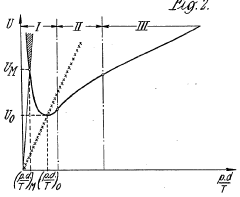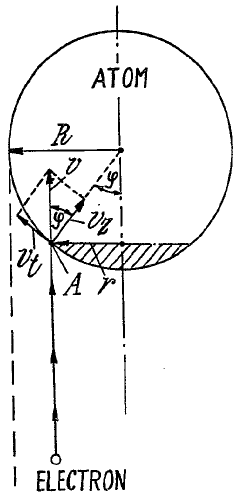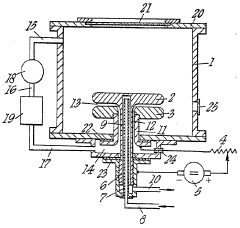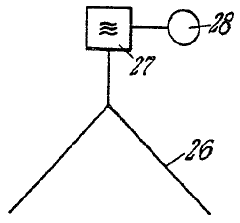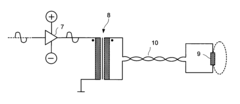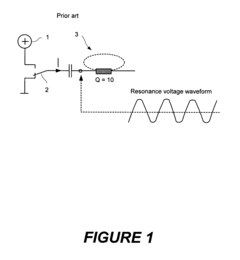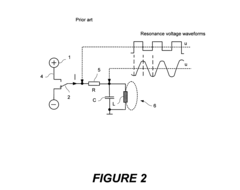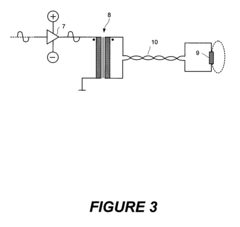How Electromagnetic Waves Power New Generation of Consumer Electronics?
JUL 11, 20259 MIN READ
Generate Your Research Report Instantly with AI Agent
Patsnap Eureka helps you evaluate technical feasibility & market potential.
EM Wave Tech Evolution
The evolution of electromagnetic wave technology in consumer electronics has been marked by significant milestones and breakthroughs. Initially, radio waves were harnessed for communication purposes, leading to the development of radio and television broadcasting. This laid the foundation for wireless technology in consumer devices.
As research progressed, the understanding of different frequencies within the electromagnetic spectrum expanded. This knowledge paved the way for the development of microwave ovens, which utilize electromagnetic waves to heat food rapidly. The principles behind this technology were later adapted for various other applications in consumer electronics.
The advent of mobile communications marked a pivotal moment in the evolution of electromagnetic wave technology. The first generation (1G) of mobile networks relied on analog signals, while subsequent generations (2G, 3G, 4G) saw a shift towards digital transmission, enabling faster data transfer and improved voice quality. This progression facilitated the widespread adoption of smartphones and other mobile devices.
Wireless charging technology emerged as another significant application of electromagnetic waves in consumer electronics. Inductive charging, which uses electromagnetic fields to transfer energy between two objects, has become increasingly common in smartphones, smartwatches, and other portable devices. This technology continues to evolve, with ongoing research into long-range wireless charging solutions.
The development of Wi-Fi technology revolutionized how consumer electronics connect and communicate. Operating primarily in the 2.4 GHz and 5 GHz frequency bands, Wi-Fi has become ubiquitous in homes, offices, and public spaces. The evolution of Wi-Fi standards (802.11a/b/g/n/ac/ax) has led to significant improvements in speed, range, and capacity.
Near Field Communication (NFC) technology, which operates at 13.56 MHz, has found widespread application in contactless payment systems and data transfer between devices. This short-range wireless technology has become a standard feature in many smartphones and other consumer electronics.
Recent advancements in electromagnetic wave technology have focused on higher frequency bands, such as millimeter waves. These are being explored for use in 5G networks and beyond, promising even faster data transfer rates and lower latency. This development is expected to enable new applications in augmented reality, virtual reality, and the Internet of Things (IoT).
The ongoing evolution of electromagnetic wave technology continues to push the boundaries of what's possible in consumer electronics. From improved energy efficiency to enhanced connectivity and novel user experiences, electromagnetic waves are at the heart of many innovations in the field.
As research progressed, the understanding of different frequencies within the electromagnetic spectrum expanded. This knowledge paved the way for the development of microwave ovens, which utilize electromagnetic waves to heat food rapidly. The principles behind this technology were later adapted for various other applications in consumer electronics.
The advent of mobile communications marked a pivotal moment in the evolution of electromagnetic wave technology. The first generation (1G) of mobile networks relied on analog signals, while subsequent generations (2G, 3G, 4G) saw a shift towards digital transmission, enabling faster data transfer and improved voice quality. This progression facilitated the widespread adoption of smartphones and other mobile devices.
Wireless charging technology emerged as another significant application of electromagnetic waves in consumer electronics. Inductive charging, which uses electromagnetic fields to transfer energy between two objects, has become increasingly common in smartphones, smartwatches, and other portable devices. This technology continues to evolve, with ongoing research into long-range wireless charging solutions.
The development of Wi-Fi technology revolutionized how consumer electronics connect and communicate. Operating primarily in the 2.4 GHz and 5 GHz frequency bands, Wi-Fi has become ubiquitous in homes, offices, and public spaces. The evolution of Wi-Fi standards (802.11a/b/g/n/ac/ax) has led to significant improvements in speed, range, and capacity.
Near Field Communication (NFC) technology, which operates at 13.56 MHz, has found widespread application in contactless payment systems and data transfer between devices. This short-range wireless technology has become a standard feature in many smartphones and other consumer electronics.
Recent advancements in electromagnetic wave technology have focused on higher frequency bands, such as millimeter waves. These are being explored for use in 5G networks and beyond, promising even faster data transfer rates and lower latency. This development is expected to enable new applications in augmented reality, virtual reality, and the Internet of Things (IoT).
The ongoing evolution of electromagnetic wave technology continues to push the boundaries of what's possible in consumer electronics. From improved energy efficiency to enhanced connectivity and novel user experiences, electromagnetic waves are at the heart of many innovations in the field.
Market Demand Analysis
The market demand for electromagnetic wave-powered consumer electronics has been steadily growing, driven by the increasing need for wireless and efficient charging solutions. This technology has found applications in various consumer devices, including smartphones, smartwatches, wireless earbuds, and other portable electronics. The convenience of cordless charging and the potential for improved energy efficiency have made electromagnetic wave-powered devices increasingly attractive to consumers.
The global wireless charging market, which heavily relies on electromagnetic wave technology, is projected to experience significant growth in the coming years. This growth is fueled by the rising adoption of electric vehicles, wearable devices, and IoT-enabled products. The automotive sector, in particular, has shown a strong interest in electromagnetic wave-powered charging solutions for electric vehicles, potentially revolutionizing the way we refuel our cars.
Consumer demand for faster charging speeds and greater convenience has been a key driver in the development of electromagnetic wave-powered technologies. As users become more reliant on their electronic devices, the ability to charge quickly and effortlessly has become a crucial factor in purchasing decisions. This has led to increased investment in research and development by major technology companies to improve the efficiency and capabilities of electromagnetic wave-powered charging systems.
The healthcare industry has also shown growing interest in electromagnetic wave-powered devices. Medical implants and wearable health monitors that can be charged wirelessly offer significant advantages in terms of patient comfort and device longevity. This emerging market segment presents substantial growth opportunities for electromagnetic wave technology in consumer health electronics.
Environmental concerns and the push for sustainable technologies have further bolstered the demand for electromagnetic wave-powered solutions. These systems have the potential to reduce electronic waste by eliminating the need for disposable batteries in many devices. Additionally, the ability to charge multiple devices simultaneously and efficiently could lead to overall energy savings in households and businesses.
Despite the growing demand, challenges remain in terms of standardization and compatibility across different devices and manufacturers. Consumers are increasingly looking for universal charging solutions that can work with a wide range of products, regardless of brand or model. This has led to industry-wide efforts to develop common standards and protocols for electromagnetic wave-powered charging technologies.
As the technology continues to evolve, there is a rising demand for more advanced applications, such as long-range wireless charging and the ability to charge devices through various materials. These innovations could potentially transform how we interact with and power our electronic devices, opening up new possibilities for product design and functionality in the consumer electronics market.
The global wireless charging market, which heavily relies on electromagnetic wave technology, is projected to experience significant growth in the coming years. This growth is fueled by the rising adoption of electric vehicles, wearable devices, and IoT-enabled products. The automotive sector, in particular, has shown a strong interest in electromagnetic wave-powered charging solutions for electric vehicles, potentially revolutionizing the way we refuel our cars.
Consumer demand for faster charging speeds and greater convenience has been a key driver in the development of electromagnetic wave-powered technologies. As users become more reliant on their electronic devices, the ability to charge quickly and effortlessly has become a crucial factor in purchasing decisions. This has led to increased investment in research and development by major technology companies to improve the efficiency and capabilities of electromagnetic wave-powered charging systems.
The healthcare industry has also shown growing interest in electromagnetic wave-powered devices. Medical implants and wearable health monitors that can be charged wirelessly offer significant advantages in terms of patient comfort and device longevity. This emerging market segment presents substantial growth opportunities for electromagnetic wave technology in consumer health electronics.
Environmental concerns and the push for sustainable technologies have further bolstered the demand for electromagnetic wave-powered solutions. These systems have the potential to reduce electronic waste by eliminating the need for disposable batteries in many devices. Additionally, the ability to charge multiple devices simultaneously and efficiently could lead to overall energy savings in households and businesses.
Despite the growing demand, challenges remain in terms of standardization and compatibility across different devices and manufacturers. Consumers are increasingly looking for universal charging solutions that can work with a wide range of products, regardless of brand or model. This has led to industry-wide efforts to develop common standards and protocols for electromagnetic wave-powered charging technologies.
As the technology continues to evolve, there is a rising demand for more advanced applications, such as long-range wireless charging and the ability to charge devices through various materials. These innovations could potentially transform how we interact with and power our electronic devices, opening up new possibilities for product design and functionality in the consumer electronics market.
Tech Challenges
The integration of electromagnetic waves into consumer electronics faces several significant technical challenges. One primary obstacle is the efficient conversion of electromagnetic energy into usable electrical power. While the concept is promising, current conversion efficiencies remain relatively low, typically ranging from 10% to 30%. This limitation restricts the practical application of electromagnetic wave-powered devices, particularly for high-power consumption electronics.
Another critical challenge lies in the development of compact and cost-effective antenna systems capable of capturing a wide spectrum of electromagnetic waves. The size and design of these antennas directly impact the device's form factor and overall efficiency. Engineers must balance the need for broad-spectrum reception with the constraints of consumer device dimensions, often leading to compromises in performance.
The issue of power density presents a further hurdle. Ambient electromagnetic waves, while ubiquitous, often have low power density in most environments. This necessitates the development of highly sensitive receivers and efficient power management systems to harvest and utilize even minute amounts of energy effectively. The challenge intensifies in areas with weak electromagnetic fields, potentially limiting the technology's applicability in certain geographical locations or indoor settings.
Interference and signal consistency pose additional technical difficulties. Consumer electronics powered by electromagnetic waves must contend with varying signal strengths, potential sources of interference, and the dynamic nature of electromagnetic environments. Designing robust systems that can maintain stable power output under these fluctuating conditions remains a significant engineering challenge.
Moreover, the integration of electromagnetic wave harvesting technology with existing electronic components and circuitry presents its own set of challenges. Engineers must develop innovative ways to seamlessly incorporate these new power systems into devices without compromising their functionality or increasing their complexity and cost significantly.
Safety considerations also play a crucial role in the development of this technology. While electromagnetic waves are generally considered safe at low power levels, the long-term effects of continuous exposure to devices harvesting these waves need thorough investigation. Ensuring compliance with international safety standards and addressing public concerns about electromagnetic radiation is essential for widespread adoption.
Lastly, the scalability of electromagnetic wave power technology presents a significant challenge. While it may be feasible for low-power devices like sensors or small wearables, scaling up to power larger consumer electronics such as smartphones or laptops requires substantial advancements in energy harvesting and storage technologies. Overcoming these scaling limitations is crucial for the technology to have a broader impact on the consumer electronics market.
Another critical challenge lies in the development of compact and cost-effective antenna systems capable of capturing a wide spectrum of electromagnetic waves. The size and design of these antennas directly impact the device's form factor and overall efficiency. Engineers must balance the need for broad-spectrum reception with the constraints of consumer device dimensions, often leading to compromises in performance.
The issue of power density presents a further hurdle. Ambient electromagnetic waves, while ubiquitous, often have low power density in most environments. This necessitates the development of highly sensitive receivers and efficient power management systems to harvest and utilize even minute amounts of energy effectively. The challenge intensifies in areas with weak electromagnetic fields, potentially limiting the technology's applicability in certain geographical locations or indoor settings.
Interference and signal consistency pose additional technical difficulties. Consumer electronics powered by electromagnetic waves must contend with varying signal strengths, potential sources of interference, and the dynamic nature of electromagnetic environments. Designing robust systems that can maintain stable power output under these fluctuating conditions remains a significant engineering challenge.
Moreover, the integration of electromagnetic wave harvesting technology with existing electronic components and circuitry presents its own set of challenges. Engineers must develop innovative ways to seamlessly incorporate these new power systems into devices without compromising their functionality or increasing their complexity and cost significantly.
Safety considerations also play a crucial role in the development of this technology. While electromagnetic waves are generally considered safe at low power levels, the long-term effects of continuous exposure to devices harvesting these waves need thorough investigation. Ensuring compliance with international safety standards and addressing public concerns about electromagnetic radiation is essential for widespread adoption.
Lastly, the scalability of electromagnetic wave power technology presents a significant challenge. While it may be feasible for low-power devices like sensors or small wearables, scaling up to power larger consumer electronics such as smartphones or laptops requires substantial advancements in energy harvesting and storage technologies. Overcoming these scaling limitations is crucial for the technology to have a broader impact on the consumer electronics market.
Current EM Solutions
01 Wireless power transmission systems
These systems utilize electromagnetic waves to transmit power wirelessly over distances. They typically involve a transmitter that converts electrical energy into electromagnetic waves and a receiver that converts the waves back into electrical energy. This technology has applications in charging electronic devices and powering various equipment without physical connections.- Wireless power transmission systems: Systems for transmitting power wirelessly using electromagnetic waves. These systems typically include transmitters, receivers, and methods for efficiently transferring energy over distances without wires. Applications include charging electronic devices and powering IoT sensors.
- Electromagnetic wave measurement and detection: Techniques and devices for measuring and detecting electromagnetic wave power. This includes methods for accurately quantifying the strength and characteristics of electromagnetic signals, which is crucial for various applications in communications, radar, and scientific research.
- Energy harvesting from electromagnetic waves: Methods and devices for capturing and converting ambient electromagnetic energy into usable electrical power. This technology aims to harness electromagnetic waves from various sources in the environment to power low-energy devices or supplement other power sources.
- Electromagnetic shielding and protection: Techniques for shielding electronic devices and biological systems from potentially harmful electromagnetic waves. This includes developing materials and structures that can absorb, reflect, or redirect electromagnetic energy to protect sensitive equipment or living organisms.
- Electromagnetic wave applications in agriculture: Utilization of electromagnetic waves in agricultural practices. This includes using electromagnetic energy for pest control, plant growth stimulation, and soil treatment. The technology aims to improve crop yields and reduce reliance on chemical treatments in farming.
02 Electromagnetic wave measurement and detection
This category focuses on methods and devices for measuring and detecting electromagnetic waves. It includes technologies for analyzing wave characteristics, such as frequency, amplitude, and power. These systems are crucial for various applications, including communications, scientific research, and environmental monitoring.Expand Specific Solutions03 Electromagnetic wave shielding and protection
This area involves techniques and materials designed to shield electronic devices and living organisms from potentially harmful electromagnetic waves. It includes the development of protective enclosures, coatings, and fabrics that can absorb or reflect electromagnetic radiation, reducing its impact on sensitive components or biological systems.Expand Specific Solutions04 Electromagnetic wave applications in agriculture
This category explores the use of electromagnetic waves in agricultural practices. It includes technologies for pest control, plant growth stimulation, and soil treatment using controlled electromagnetic radiation. These applications aim to improve crop yields and reduce the need for chemical interventions in farming.Expand Specific Solutions05 Energy harvesting from electromagnetic waves
This field focuses on technologies that capture and convert ambient electromagnetic waves into usable electrical energy. It includes the development of specialized antennas and circuits designed to harvest energy from various sources of electromagnetic radiation, such as radio waves, Wi-Fi signals, and other forms of wireless transmissions.Expand Specific Solutions
Key Industry Players
The electromagnetic wave technology in consumer electronics is in a mature growth phase, with a substantial market size driven by increasing demand for wireless charging and connectivity solutions. The technology's maturity is evident from the involvement of established players like Hitachi Ltd., Kyocera Corp., and POSCO Holdings, Inc., who are leveraging their expertise in materials and electronics to develop advanced applications. Research institutions such as the Electronics & Telecommunications Research Institute and universities like Chongqing University are contributing to further innovation in this field. The competitive landscape is diverse, with companies like 3M Innovative Properties Co. and Honeywell International Technologies Ltd. focusing on specific aspects of electromagnetic wave technology, indicating a segmented market with opportunities for specialization and differentiation.
3M Innovative Properties Co.
Technical Solution: 3M has developed a unique approach to electromagnetic wave power transmission for consumer electronics, leveraging their expertise in materials science. Their system utilizes specially designed dielectric materials and metamaterial structures to enhance near-field coupling efficiency in the MHz frequency range[1]. 3M's technology allows for flexible and conformal power transmission surfaces that can be integrated into furniture, walls, or other everyday objects. They have demonstrated charging of multiple small devices within a 1-3 meter range with efficiencies comparable to traditional wired charging[2]. The company is also exploring the use of their materials in wearable electronics for seamless power transfer in smart clothing and accessories[3].
Strengths: Flexible and easily integrated power transmission surfaces, suitable for a wide range of consumer applications. Weaknesses: Limited to relatively short ranges, may require significant modifications to existing products and environments.
Honeywell International Technologies Ltd.
Technical Solution: Honeywell has developed a novel approach to electromagnetic wave power transmission for consumer electronics, focusing on industrial and aerospace applications. Their system utilizes resonant inductive coupling, operating in the MHz frequency range, to achieve efficient power transfer over medium distances[1]. Honeywell's technology incorporates adaptive frequency tuning to optimize power transfer efficiency as device positions change. They have demonstrated charging of multiple devices simultaneously within a 3-5 meter range[2]. The company is also exploring integration with smart building systems to create large-scale wireless charging environments for offices and public spaces[3].
Strengths: Efficient power transfer over medium distances, suitable for larger spaces and multiple devices. Weaknesses: Higher complexity and cost compared to short-range solutions.
Core EM Innovations
Process and device for the generation of electromagnetic waves
PatentInactiveGB977559A
Innovation
- A method involving a gas discharge in a high-density gas environment with controlled electric fields, where the electric field strength is sufficient to ionize atoms without exciting them, preventing energy conversion into light radiation and optimizing the generation of electromagnetic waves in the desired frequency range.
Device for generating electromagnetic waves, method for operating a device of this type and method for modulating the electromagnetic waves to be generated using a device of this type in accordance with data to be transmitted
PatentInactiveUS7064312B2
Innovation
- A device comprising an energy supply with a choke coil and oscillating circuit, where the energy supply includes a DC voltage source, a converter coil, and push-pull switches, operating the choke coil in saturation during transient conditions to enhance output power and efficiency, and using a transformer for efficient energy transfer.
Safety Regulations
As electromagnetic waves become increasingly prevalent in powering consumer electronics, safety regulations play a crucial role in ensuring the well-being of users and the environment. Regulatory bodies worldwide have established guidelines and standards to address potential health risks associated with electromagnetic radiation exposure.
The International Commission on Non-Ionizing Radiation Protection (ICNIRP) has set exposure limits for electromagnetic fields, which are widely adopted by many countries. These guidelines cover a broad spectrum of frequencies, including those used in wireless charging and power transfer technologies. Manufacturers must adhere to these limits to ensure their products meet safety standards.
In the United States, the Federal Communications Commission (FCC) regulates electromagnetic emissions from electronic devices. The FCC has established specific absorption rate (SAR) limits for devices that emit radiofrequency energy, such as smartphones and wireless chargers. These regulations aim to prevent excessive tissue heating and other potential biological effects from electromagnetic exposure.
The European Union has implemented the Radio Equipment Directive (RED), which sets essential requirements for radio equipment, including those utilizing electromagnetic waves for power transfer. This directive ensures that devices sold in the EU market comply with health and safety standards, as well as electromagnetic compatibility requirements.
Safety regulations also address electromagnetic interference (EMI) concerns. As more devices incorporate wireless charging and power transfer technologies, the potential for EMI increases. Regulatory bodies have established limits on electromagnetic emissions to prevent interference with other electronic devices, particularly in sensitive environments such as hospitals and aircraft.
Manufacturers must conduct extensive testing and obtain certifications to demonstrate compliance with these safety regulations. This process involves evaluating electromagnetic field strengths, SAR values, and EMI levels under various operating conditions. Third-party testing laboratories often perform these assessments to ensure impartiality and accuracy.
As technology evolves, safety regulations are continuously reviewed and updated to address new challenges. For instance, the emergence of high-power wireless charging systems for electric vehicles has prompted regulatory bodies to develop specific guidelines for this application. These regulations consider factors such as charging efficiency, electromagnetic exposure to vehicle occupants, and potential environmental impacts.
Consumer awareness and education are also essential components of safety regulations. Manufacturers are required to provide clear information about the safe use of their products, including recommended operating distances and potential interference with medical devices. This information helps users make informed decisions and minimize potential risks associated with electromagnetic wave-powered devices.
The International Commission on Non-Ionizing Radiation Protection (ICNIRP) has set exposure limits for electromagnetic fields, which are widely adopted by many countries. These guidelines cover a broad spectrum of frequencies, including those used in wireless charging and power transfer technologies. Manufacturers must adhere to these limits to ensure their products meet safety standards.
In the United States, the Federal Communications Commission (FCC) regulates electromagnetic emissions from electronic devices. The FCC has established specific absorption rate (SAR) limits for devices that emit radiofrequency energy, such as smartphones and wireless chargers. These regulations aim to prevent excessive tissue heating and other potential biological effects from electromagnetic exposure.
The European Union has implemented the Radio Equipment Directive (RED), which sets essential requirements for radio equipment, including those utilizing electromagnetic waves for power transfer. This directive ensures that devices sold in the EU market comply with health and safety standards, as well as electromagnetic compatibility requirements.
Safety regulations also address electromagnetic interference (EMI) concerns. As more devices incorporate wireless charging and power transfer technologies, the potential for EMI increases. Regulatory bodies have established limits on electromagnetic emissions to prevent interference with other electronic devices, particularly in sensitive environments such as hospitals and aircraft.
Manufacturers must conduct extensive testing and obtain certifications to demonstrate compliance with these safety regulations. This process involves evaluating electromagnetic field strengths, SAR values, and EMI levels under various operating conditions. Third-party testing laboratories often perform these assessments to ensure impartiality and accuracy.
As technology evolves, safety regulations are continuously reviewed and updated to address new challenges. For instance, the emergence of high-power wireless charging systems for electric vehicles has prompted regulatory bodies to develop specific guidelines for this application. These regulations consider factors such as charging efficiency, electromagnetic exposure to vehicle occupants, and potential environmental impacts.
Consumer awareness and education are also essential components of safety regulations. Manufacturers are required to provide clear information about the safe use of their products, including recommended operating distances and potential interference with medical devices. This information helps users make informed decisions and minimize potential risks associated with electromagnetic wave-powered devices.
Energy Efficiency
The integration of electromagnetic waves in consumer electronics has led to significant advancements in energy efficiency. This technology has revolutionized the way devices are powered, offering wireless charging solutions that reduce the need for traditional wired connections. Electromagnetic induction, a key principle in this field, allows for the transfer of energy between devices without physical contact, minimizing energy loss during the charging process.
One of the primary benefits of electromagnetic wave-powered devices is their ability to optimize power consumption. By utilizing resonant coupling techniques, these systems can transfer energy more efficiently over longer distances, reducing the amount of power wasted during transmission. This is particularly advantageous for portable devices, where battery life is a critical factor in user experience and overall device performance.
The development of smart power management systems in conjunction with electromagnetic wave technology has further enhanced energy efficiency. These systems can dynamically adjust power transfer rates based on the device's needs, ensuring that only the necessary amount of energy is transmitted. This adaptive approach not only conserves energy but also extends the lifespan of batteries by preventing overcharging and reducing heat generation.
Moreover, the implementation of electromagnetic wave technology in consumer electronics has paved the way for energy harvesting techniques. Devices can now capture ambient electromagnetic waves from various sources, such as Wi-Fi signals or radio frequencies, and convert them into usable power. This passive energy collection method contributes to overall energy efficiency by supplementing battery power and reducing the frequency of active charging sessions.
The integration of electromagnetic wave technology with Internet of Things (IoT) devices has also led to more efficient energy distribution in smart homes and offices. By enabling seamless communication between devices, power can be allocated more effectively across a network of interconnected electronics, optimizing energy usage on a broader scale.
As the technology continues to evolve, researchers are exploring ways to further improve the energy efficiency of electromagnetic wave-powered devices. This includes the development of more advanced materials for electromagnetic shielding, which can minimize energy loss and interference, as well as the optimization of coil designs to enhance power transfer efficiency. These ongoing advancements promise to push the boundaries of energy efficiency in consumer electronics, leading to more sustainable and environmentally friendly devices in the future.
One of the primary benefits of electromagnetic wave-powered devices is their ability to optimize power consumption. By utilizing resonant coupling techniques, these systems can transfer energy more efficiently over longer distances, reducing the amount of power wasted during transmission. This is particularly advantageous for portable devices, where battery life is a critical factor in user experience and overall device performance.
The development of smart power management systems in conjunction with electromagnetic wave technology has further enhanced energy efficiency. These systems can dynamically adjust power transfer rates based on the device's needs, ensuring that only the necessary amount of energy is transmitted. This adaptive approach not only conserves energy but also extends the lifespan of batteries by preventing overcharging and reducing heat generation.
Moreover, the implementation of electromagnetic wave technology in consumer electronics has paved the way for energy harvesting techniques. Devices can now capture ambient electromagnetic waves from various sources, such as Wi-Fi signals or radio frequencies, and convert them into usable power. This passive energy collection method contributes to overall energy efficiency by supplementing battery power and reducing the frequency of active charging sessions.
The integration of electromagnetic wave technology with Internet of Things (IoT) devices has also led to more efficient energy distribution in smart homes and offices. By enabling seamless communication between devices, power can be allocated more effectively across a network of interconnected electronics, optimizing energy usage on a broader scale.
As the technology continues to evolve, researchers are exploring ways to further improve the energy efficiency of electromagnetic wave-powered devices. This includes the development of more advanced materials for electromagnetic shielding, which can minimize energy loss and interference, as well as the optimization of coil designs to enhance power transfer efficiency. These ongoing advancements promise to push the boundaries of energy efficiency in consumer electronics, leading to more sustainable and environmentally friendly devices in the future.
Unlock deeper insights with Patsnap Eureka Quick Research — get a full tech report to explore trends and direct your research. Try now!
Generate Your Research Report Instantly with AI Agent
Supercharge your innovation with Patsnap Eureka AI Agent Platform!
